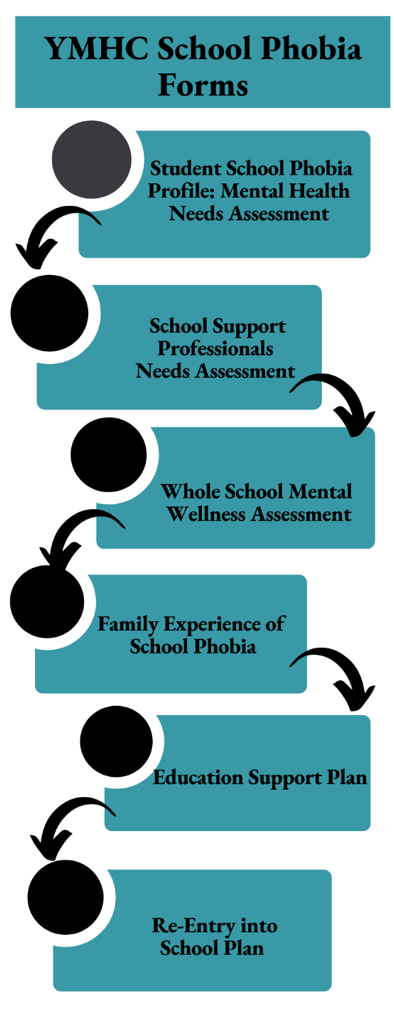- Background on School Phobia
- Participants Background and Demographics
- School Mental Wellness Protective Factors
- School Experience: Disability Support
- The Experience of Parents
- Punitive Approaches and Experience of Educational Exclusion
- A Needs-Based Approach
- Conclusion
School Phobia and Chronic Absenteeism Recommendations
YMHC School-Wide Strategy and YMHC ARPRAE Strategy:
ARPRAE (Assess-Review-Plan-Review-Act-Evaluate)
Implement the YMHC School Phobia Action Plan:
- Create comprehensive, school-based approaches: use forms to collect information, develop strategies, and implement action, re-entry, and support plans. Assessment, review, and evaluation are an ongoing process of gathering, analysing, and interpreting information, feedback, and input to reflect on findings and make informed and consistent decisions and actions to better support the student
2. Assess: Information Gathering
- Read all documentation about student learning needs, challenges, and strengths
- Complete the Student School Phobia Profile: Mental Health Needs Assessment Form
- Complete the School Support Professionals Needs Assessment Form
- Complete the Student Education Support Assessment Form
- Complete the Whole School Mental Wellness Assessment
- Complete the Family Experience of School Phobia Form
Review: Compile all documentation and review
Plan: Create an Education Support Plan
- School Climate: Create a positive school atmosphere with a strong sense of community between students and the teachers. Create, maintain, and encourage students to belong to school clubs, associations, teams, and organizations to ensure that students feel a sense of community, connection, caring, and belonging.
- Communication: The most important is to make sure that every member of school staff is fully aware of the student’s difficulties: what makes school phobia worse, ways to support the student and transition and re-entry plans that need to be understood and followed. School re-entry transitional plans can fail when there is a lack of consistency and communication.
- Safe Person: Having a designated ‘safe’ person: a “trusted adult” in the school. This should be someone the student chooses: someone they a foundation of trust and communication. If they feel they have someone to go to other than at home, they’re more likely to feel able to go and stay at school.
- Safe Place: A ‘safe place’. Often children with anxiety like to have somewhere to escape to if they feel overwhelmed. This can be the office of someone they trust, the library or resource room.
- Coping Communication: Give student a special card that they can show a teacher that allows them to leave a classroom unquestioned. There should be a plan in place for where the student goes when they need to take a mental health pause or break.
- Peer Support: Establish peer support, buddy systems, and mentoring programs in schools to increase mental wellness protective factors that support a greater sense of community, connection, and belonging. Using someone appropriate who is older or who has experienced something similar and can offer support to a child is a great way to show that it can get easier. Register for YMHC’s School Peer Support program to get free downloads of 24 compassionate greeting cards. Create a Peer Support team to respond to students who are struggling with messages of support.
- Meaningful Contribution: Give the child a ‘special’ role/job or appeal to their interests, ask them to help organise something etc., that gives them motivation and helps them associate school with something positive.
- Safe Communication: When developing re-entry and support plans, arrange to meet with the student experiencing school absence due to anxiety and phobia after school hours to minimize interactions and build safety, trust, and communication.
- Educational Accommodation Supports: Work with the student to devise a timetable that feels manageable. Use the “Possible Educational Accommodations” in the guidebook as a reference for needs-based accommodations that a student might find helpful.
Review: Review the plan. Ensure that all people involved in the Education Support Team understand their roles and responsibilities.
Act: Education Support Action Plan
- Develop, communicate information about and implement the School Re-Entry Action Plan
- Develop, communicate information about and facilitate the Education Support Team
- Implement the proposed timetable with regular reviews: Re-Entry Schedule and Support Plan
Evaluate Progress: Assess, Evaluate and Implement Education Support Plans
- Background on School Phobia
- Participants Background and Demographics
- School Mental Wellness Protective Factors
- School Experience: Disability Support
- The Experience of Parents
- Punitive Approaches and Experience of Educational Exclusion
- A Needs-Based Approach
- Conclusion


